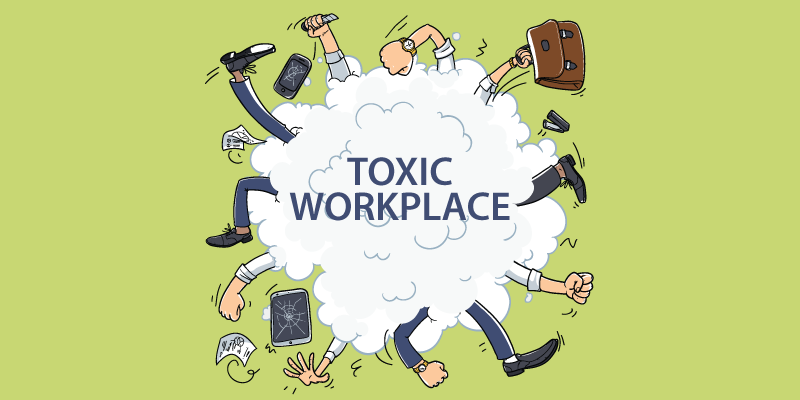
A few months back, a post shared on the SubReddit ‘Anti Work’ went viral, garnering over 30,000 upvotes. The Redditor shared an image of a chair with a sign that read, ‘Not for employee use.’ Utterly shocked at this novel way to “increase productivity”, the caption read:
“Walked into work today to find chairs missing. The chairs up front for customers are still available but all chairs used by employees during downtime and breaktime have been removed. Apparently, this is being done to increase productivity.”
Sounds like a nightmare, right?
The very sight of an offer letter popping into our mailboxes gives us immense joy, a sense of fulfilment and the hunger to reach the summit of success. But what if the tables turn and you find yourself working in a dragon lair, amidst searing fireballs?
Well, workplace toxicity can be worse than that.
Toxic workplaces and how to identify them
Findings from a survey conducted by the Workforce Institute at UKG reveal that managers have a greater impact on employees’ mental health (69%) compared to doctors (51%), placing them on par with the influence of a spouse or partner (69%). It’s clearly understandable how much a toxic workplace is capable of wreaking havoc on your mental and physical well-being, job satisfaction, and overall quality of life.
Do you find yourself in a similar demoralising, disheartening and frustrating situation? Chances are, you’re stuck in an unhealthy work environment. Worry not! In this blog, we’ll delve deep into six red flags of a toxic workplace, empowering you to spot them and make informed decisions.

Red flag #1: Your boss questions your 10-minute restroom break
Your life has been reduced to nothing but a set of The Devil Wears Prada where your boss seems to take a whole lot of inspiration from the merciless, savage Miranda Priestly.
Detailed progress updates, constant approval-seeking, overzealous detailing, and incessant check-ins are the hallmarks of a micromanager’s realm. It’s like you can’t even breathe without them peering over your shoulder. Dealing with a micromanager can be the most arduous part of your workday, stifling creativity and productivity in answering questions and providing real-time updates.
But you’re not here to be an assistant in a high-fashion magazine. It’s time to regain your professional autonomy and strike a balance between guidance and trust.
Remember; a healthy workplace always steers clear of unwarranted criticism and the feeling of being “all trapped” on the part of their employees.
Red flag #2: The office serves you hot gossip every day
Entering the drama zone feels like stepping into a live rendition of “Mean Girls.” Cliques take shape, gossip spreads like wildfire, and backstabbing becomes the norm. Your first job after coming to the office is to make notes of the burning scenario.
Toxic co-workers can sour even the most enjoyable job. If you find yourself surrounded by colleagues who are persistently negative, engage in gossip, or belittle others, you’re likely stuck in a toxic work environment. Such behaviours can breed mistrust and paranoia among team members, undermining productivity and collaboration.
If such norms are rampant within the organisation, it’s a sign that HR and leadership need to take charge of it.
Red flag #3: You transition from a 9-5 employee to a 24-hour emergency ward caregiver
An often-overlooked yet critical warning sign is an imbalanced work-life situation.
If your job requires you to be constantly “on the clock,” whether sick, on vacation, or after hours, it’s essential to reassess your time commitment. Being an employee doesn’t mean being tethered to your desk or at their constant texts and calls. This imbalance leads to perpetual burnout, harming both business and employee retention. While some extra hours during special projects are acceptable, it shouldn’t be the norm.
Work should aid personal growth and offer a sense of purpose, not at the expense of a balanced life. “Hustle culture” that glorifies late hours, and lack of sleep, creates stress, anxiety, and burnout.
.thumbnailWrapper
width:6.62rem !important;
.alsoReadTitleImage
min-width: 81px !important;
min-height: 81px !important;
.alsoReadMainTitleText
font-size: 14px !important;
line-height: 20px !important;
.alsoReadHeadText
font-size: 24px !important;
line-height: 20px !important;

Red flag #4: You become the official scapegoat
Do you have leaders with strong egos and snarky attitudes who like to blame you for the slightest thing? Do you have the freedom to make mistakes and learn from them? Are you encouraged to share your feedback and offer suggestions?
Utilising employees as negative examples can foster a hostile and fear-driven workplace. Scapegoating not only undermines accountability and trust, deters talent, and damages reputation but also instils a perpetual fear in employees of becoming the next target. This, in turn, diminishes their motivation and morale and hinders their willingness to take initiative or suggest ideas due to the anticipation of negative reactions.
Frequent and meaningful recognition is key to fostering an engaged and productive workforce. Employees should seek discussions if they feel undervalued or unfulfilled. If they still don’t feel valued, it may be time to explore other opportunities.
Red flag #5: The boss never applauds your good work
Does the sight of your boss giving a pat on your back and saying You did a great job! feel like a far-fetched reality?
Then, dear, you seem to be in a dysfunctional environment.
Strong company cultures are built on shared values, collaborative efforts, and collective successes. It has a strong influence, both on the quality of work and overall performance. When employees don’t feel a part of these three vital elements, they may perceive their workplace as toxic.
To mitigate the risk of a toxic work environment, it’s essential to invest in employee recognition and rewards. Regular and meaningful recognition not only enhances productivity but also elevates employee engagement, and fosters workplace morale, and retention rates.
Performance reviews also serve as an ideal platform to discuss any work-related challenges and an employee’s desired career progression.
Red flag #6: You are a victim of ‘scope creep’
A less recognised red flag of a toxic work environment is known as ‘scope creep’. This is a gradual process where the management team or supervisor progressively adds more responsibilities to an employee beyond what was initially agreed upon in their contract.
For instance, if you were hired as an editor, and your boss asks you to write a single blog post one week, in addition to your usual editing tasks, because one of the teammates is sick. But over time, they continually assign more writing tasks and editing duties for other writers, exceeding the original scope of your role. This evolving situation is what we refer to as scope creep.
When you sense that the requests are becoming excessive, it’s essential to address the issue with your boss and request a meeting to discuss the matter. In many cases, this problem can be resolved if it’s dealt with before it escalates.
Diligence is a fundamental aspect of attaining career success, but it should not be giving you pounds of stress weight. Strive to find a workplace that fosters a positive and inclusive culture, promotes a balanced work-life dynamic, and offers fair compensation and comprehensive benefits.










![Read more about the article [Funding roundup] Unravel Data, Cheelizza, Chumbak at different stages of fundraising](https://blog.digitalsevaa.com/wp-content/uploads/2022/09/Imageyhb7-1663918776380-300x150.jpg)